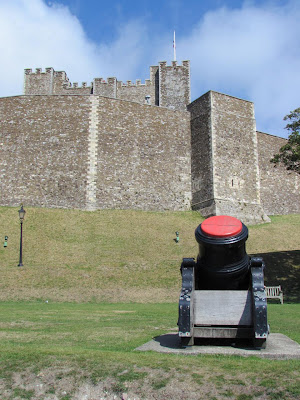Today we drove to Dover Castle. Dover Castle is a medieval castle in the town of the same name in the English county of Kent. It was founded in the 12th century and has been described as the "Key to England" due to its defensive significance throughout history. Spectacularly situated above the White Cliffs of Dover this magnificent castle has guarded English shores from invasion for 20 centuries. Dover Castle is above all a great medieval fortress, created by King Henry II and his Plantagenet successors. At its heart stands the mighty keep or Great Tower, 83 feet (25.3m) high and just under 100 feet (30m) square, with walls up to 21 feet (6.5m) thick. The grandest and among the last of the keeps raised by the kings of England during the 11th and 12th centuries, it was designed by Henry II’s architect ‘Maurice the Engineer’ and built between 1180 and 1185.
 |
| Our first glimpse of the White Cliffs of Dover |
 |
| The city of Dover |
Commanding the shortest sea crossing between England and the continent, Dover Castle has a long and immensely eventful history. Many centuries before King Henry II began the great stone castle here in the 1160s, its spectacular site atop the famous ‘White Cliffs’ was an Iron Age hill fort, and it still houses a Roman lighthouse, one of the best-preserved in Europe. The Anglo-Saxon church beside it was once probably part of a Saxon fortified settlement: very soon after his victory at Hastings in 1066, this was converted by William the Conqueror into a Norman earthwork and timber-stockaded castle.
From then on Dover Castle was garrisoned uninterruptedly until 1958, a continuous nine-century span equalled only by the Tower of London and Windsor Castle. The stronghold hosted royal visits by Henry VIII, Elizabeth I and Charles I’s Queen Henrietta Maria: and from 1740 until 1945, its defences were successively updated in response to every European war involving Britain
 |
| Constables Gate |
 |
| Medieval Tunnels |
 |
| St John's Tower |
 |
| The Keep c 1181-88 built by Henry II |
 |
| Roman Lighthouse 1st Century AD & Church of St Mary in Castro c 1000 |
 |
| Look closely and you can see the shores of France |


























No comments:
Post a Comment